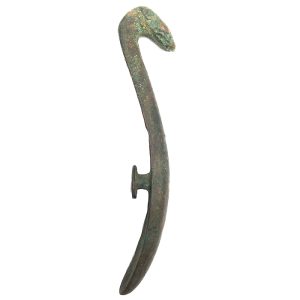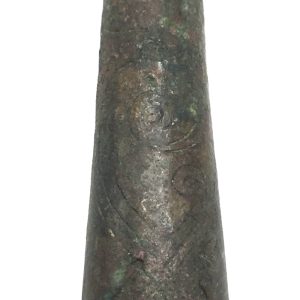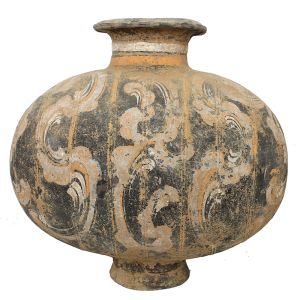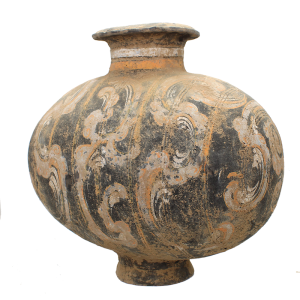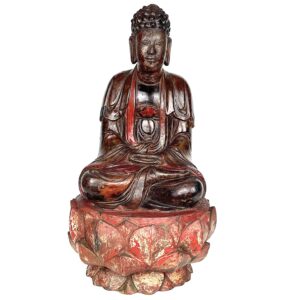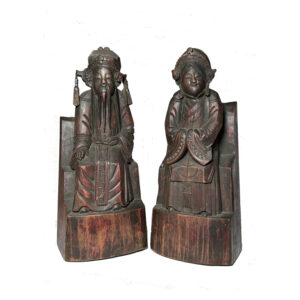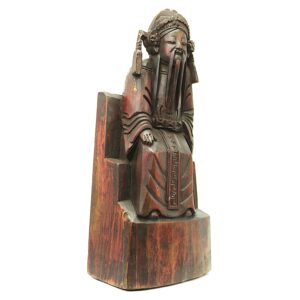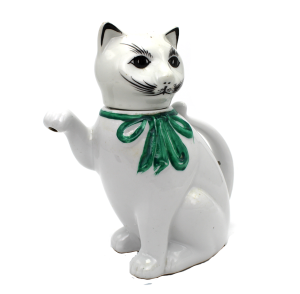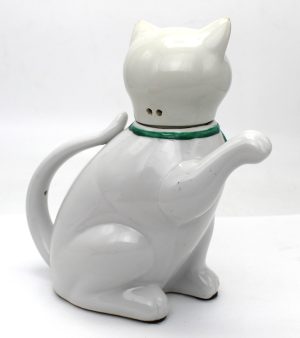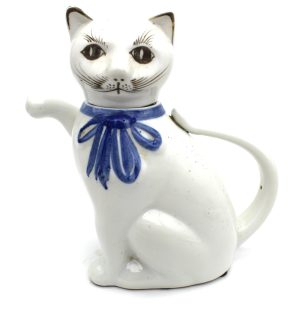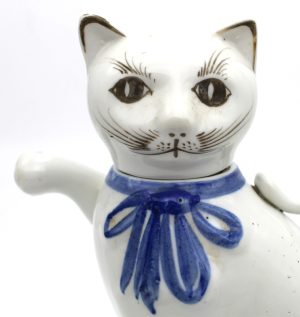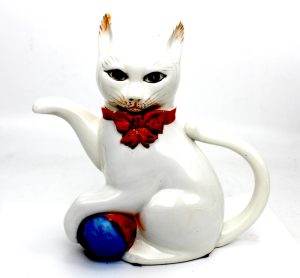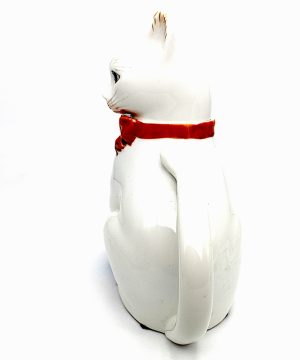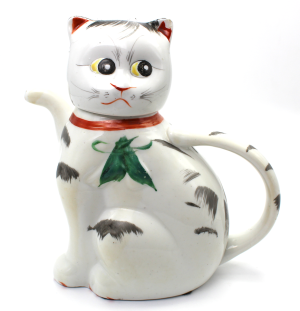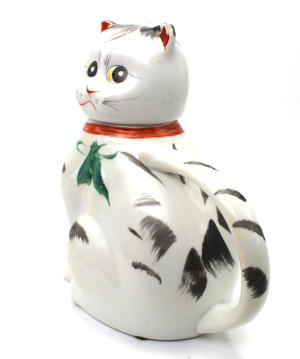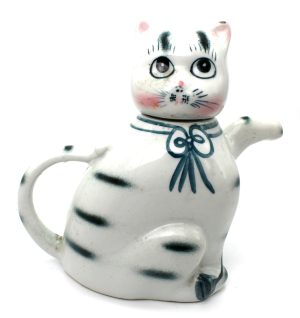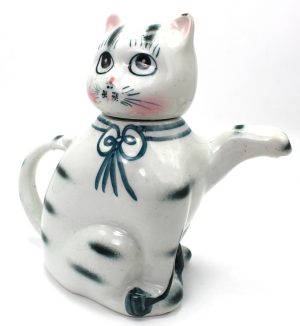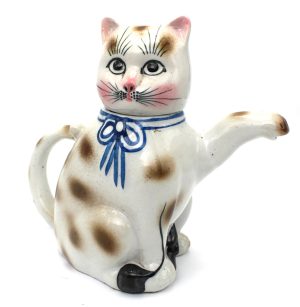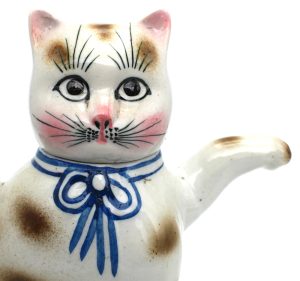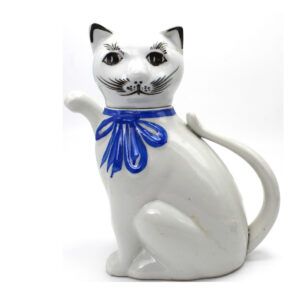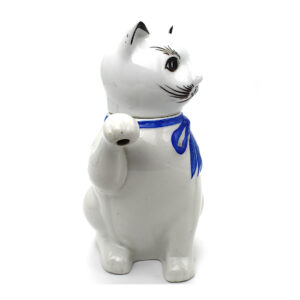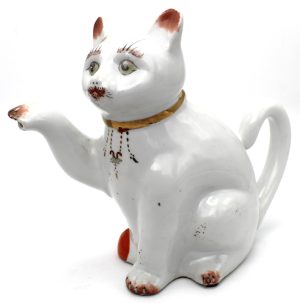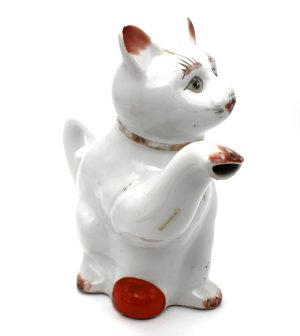Showing 229–240 of 313 results
-


$485.00
Chinese belt hooks were worn with the hook end on the wearer’s left and fastened to clothing with a button like bronze piece fixed to the belt’s end. Initially only functional, metalwork belt hooks became a symbol of wealth, high status and power by the Han Dynasty. They were made using a variety of materials…
-


$2,100.00
H: 11.75” W: 12.25” D: 7.5” | FOR SHIPPING INFORMATION CONTACT US AT 213-568-3030
Cocoon jars were mingqi made for placement in tombs to comfort the deceased on their journey to and in their afterlife. An elixir of Immortality made from mulberry leaves or their ashes was placed inside for the deceased to drink and transmigrate into the world of the beyond. Ovoid in shape to resemble a silkworm cocoon, ajar rests on a small trumpet-shaped foot and has a narrow neck and a wide lip at its mouth. Painted after firing with vertical bands dividing it into panels, swirling cloud scrolls, and circular “eye” motifs at each end, this beautiful vessel is in excellent condition for its age with expected paint losses, scrapes, and dirt adhesions.
-
Sale!


$2,900.00 Original price was: $2,900.00.$2,100.00Current price is: $2,100.00.
H: 18.75: W: 9.75” D: 9” | Call us AT 213-568-3030 fOR SHIPPING and price information
This magnificent and rare Ming Dynasty Buddha is covered with dark lacquer and indications of the vibrant gold and red pigmentation that once enhanced this image. His beautiful face radiates serenity with its benign expression as he sits in meditation on an elaborate lotus throne. Made to be viewed on all sides his three part monk’s robe extends with flowing sleeves over his feet and down his back. In excellent condition with minor paint losses, this rare masterpiece would enhance any environment with its spiritual energy and beauty.
-


$875.00
We cannot precisely identify this pair but the seller said the costume details were of opera figures which were extremely popular during the Qing dynasty until it ended. Beautifully carved from a very dense hardwood, the figure and wife sit on a 3 level pedestals with long back supports. Clearly an official with a deeply…
-


$135.00
H: 6.5″ W: 6.5″ D: 3.5″ | FREE SHIPPING WITHIN CONTINENTAL U.S.!
This charming porcelain a cat teapot with a raised paw has a removable head to pour liquid into the vessel and a long sinuous tail handle for pouring liquid from the opening at the end of the paw. The design is whimsical and colorful with a thin green ribbon collar and an impressive dangling ornamental bow with black accents defining the face, ears and head.
-


$135.00
H: 7” W: 7” D: 3.5” | FREE SHIPPING IN CONTINENTAL US!
This charming white porcelain cat teapot with a raised paw has a removable head, a sinuous tail handle, a paw spout and a removable head . Beautifully hand-painted whimsical and colorful designs include a thin ribbon-like blue collar, an impressive dangling ornamental bow, and the black accents that define the face, ears, head and paws.
-


$135.00
H: 8” W: 8” D: 3.75” | FREE SHIPPING IN CONTINENTAL US!
This charming white porcelain Siamese cat teapot has a raised paw for pouring tea, a removable head for adding water , and a long sinuous tail handle. The beautifully hand-painted design is whimsical and colorful with a thick dark red collar ribbon, a matching ornamental bow, and a ball under its left paw. Black, orange, red and blue accents define the cat’s face, ears, head, paws and the ball.
-


$145.00
H: 8” W: 8” D: 3.75” | FREE SHIPPING WITHIN CONTINENTAL U.S.!
This charming vintage porcelain cat teapot with raised paw for pouring tea, removable head and a sinuous tail handle is whimsical and colorful with a red ribbon collar, green bow and green, black and red accents defining the expressive face, ears, head and paws, all beautifully hand-painted.
-


$135.00
H: 7” W: 8” D: 3.625” | FREE SHIPPING WITHIN CONTINENTAL U.S.!
This porcelain teapot is a rotund cat figurine comically sitting on a mouse. It has a raised paw spout, a removable head and a long sinuous tail handle. The whimsical and colorful design with long ribbon and blue collar with a dangling blue bow and the black, pink, and brown accents that define the face, ears, head, paws and body and all are hand painted.
-


$135.00
H: 7” W: 8” D: 3.625” | FREE SHIPPING WITHIN CONTINENTAL U.S.!
This porcelain teapot is a rotund cat figurine comically sitting on a mouse. It has a raised paw spout, a removable head and a long sinuous tail handle. The whimsical and colorful design with long ribbon and blue collar with a dangling blue bow and the black, pink, and brown accents that define the face, ears, head, paws and body and all are hand painted.
-


$130.00
H: 8” W: 8” D: 3.75” | FREE SHIPPING WITHIN CONTINENTAL U.S.!
This charming vintage porcelain cat teapot with raised paw for pouring tea, removable head and a sinuous tail handle is whimsical and colorful with a red ribbon collar, green bow and green, black and red accents defining the expressive face, ears, head and paws, all beautifully hand-painted.
-


$130.00
Ht: 8” W: 8” D: 3.75” FREE SHIPPING WITHIN CONTINENTAL U.S.!
This large, charming Republic seated cat teapot has a raised paw and a removable head to allow hot water to be poured inside through the neck and a long, a sinuously curved cat tail handle that allows one to pour liquid out the hole at the end of the paw. Whimsically painted with a decorative collar it represents a gesture of greeting and hospitality it is believed to welcome good luck and fortune.
End of content
End of content

